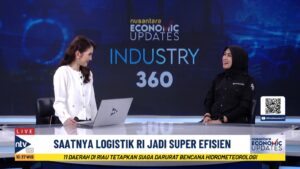Supply Chain Diversification as a Solution for Indonesia’s Logistics Efficiency
Posted on September 23, 2024 by Nur Wachda Mihmidati

Indonesia’s logistics and supply chain industry has experienced significant inefficiencies in recent years, with the ratio of logistics costs to GDP reaching more than 23% since 2015. This condition creates major challenges for the economy, especially when compared to other countries in the Asian region. To address this issue, the Indonesian government has launched various initiatives to improve the efficiency of the logistics sector, including supply chain diversification and national projects such as logistics platforms and the sea toll program. The ambitious target is to lower logistics costs to 17% by 2024, as part of Indonesia’s long-term vision to become one of the world’s five to seven largest economies by 2045.
While such efforts are underway, the dominance of land transportation in the logistics sector remains strong, with 70% to 80% of freight shipments made by land. On the other hand, Indonesia’s logistics market is still largely dominated by local companies, with only 30% of the market filled by multinational companies. Nonetheless, the sector is expected to continue growing at a compound annual growth rate (CAGR) of 9% in the next few years, driven by increasing attention to infrastructure development and transportation efficiency.
Supply Chain Disruption Challenges in Various Industry Sectors
Industries in various sectors are currently facing a variety of challenges related to supply chain disruption, triggered by a number of external and internal factors. One of the main challenges is global economic uncertainty and rising prices affecting the food and beverage industry. This sector must find alternatives for raw materials and seek import substitution to maintain production stability. On the other hand, the textile and garment industry is trying to overcome the invasion of imported goods and strengthen local products to maintain domestic market share.
Other sectors, such as chemicals and pharmaceuticals, are also faced with challenges related to the use of local raw materials and gaps in the national industrial structure. On the academic and policy side, there are concerns about supply chain bottlenecks, changes in demand, and higher inflation, which cause significant disruptions in product delivery and availability. Executives in the industry face pressure from rising raw material prices as well as the need to meet growing consumer demand. These challenges point to the need for strategic diversification and greater efficiency in the supply chain to mitigate the impact of disruption.
Diversification Strategy in Facing Supply Chain Crisis in Indonesia
Global supply chain disruption has created major challenges for domestic producers in Indonesia, especially in terms of raw material supply. The Covid-19 pandemic and geopolitical conflicts such as the Russia-Ukraine war exacerbated the situation, causing raw material scarcity and economic uncertainty. Many manufacturers depend on imported materials that are difficult to obtain, making this issue a disaster for the industry. In addition, global economic stagflation adds to the pressure with rising raw material prices and unexpected inflation. Faced with this situation, local manufacturers should adopt a strategy of diversification and raw material substitution to reduce dependence on imported supplies, while seeking opportunities to build a more inclusive supply chain domestically. This strategy involves working with Small and Medium Enterprises (SMEs) to improve domestic supply chain security.
Diversification Strategy in Support of Indonesia’s E-Commerce Growth
Indonesia is one of the most promising e-commerce markets in the Asia-Pacific region, with growth fueled by widespread internet usage, digitization, and the development of online shopping platforms. In 2021, internet penetration in Indonesia reached 72.87%, making it one of the highest in the region. E-commerce growth in Indonesia is expected to continue accelerating at a high double-digit rate, and is even projected to account for 50% of Southeast Asia’s total e-commerce transactions by 2025. With the number of online shoppers increasing from 75 million before the pandemic to 85 million, the demand for delivery services has soared, creating new challenges for supply chains in Indonesia.
To meet these challenges, supply chain diversification is a key solution. Indonesia’s diverse and complex supply chain currently requires significant adjustments to meet the needs of the rapidly growing e-commerce market. Supply chain diversification can help Indonesia’s e-commerce industry adapt to various infrastructure and geography constraints, and ensure operational efficiency. This will enable more choices in logistics resources, balancing consumer demand and available distribution capacity, thus strengthening Indonesia’s position as a regional e-commerce hub in the future.
In the face of global supply chain disruption, diversification and raw material substitution are indispensable solutions for Indonesian manufacturers to reduce dependence on imported supplies. With diversification strategies, companies can not only ensure production continuity, but also create supply chains that are more resilient and responsive to market changes. Cooperation with local SMEs as well as support from government policies will strengthen domestic supply chain security, reduce the risk of raw material shortages, and optimize production costs.
To facilitate and accelerate the process of supply chain diversification, Logistic Service Integrator such as TransTRACK is present as a strategic partner. TransTRACK offers integrated solutions that assist companies in managing logistics flows, from sourcing local raw materials to optimizing shipments. With advanced technology and an extensive logistics network, TransTRACK can help businesses identify alternative raw material sources, coordinate distribution, and ensure timeliness and operational efficiency. Adopting this integrated logistics solution is the right step to ensure business sustainability amidst global uncertainty.
Recent Post
Topic :
 Bahasa Indonesia
Bahasa Indonesia









